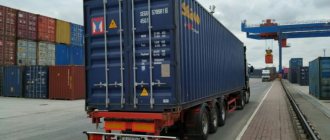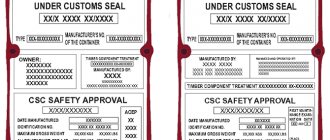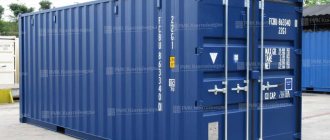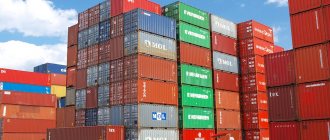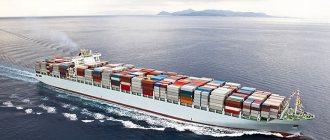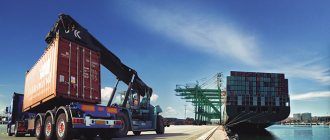What is the difference between FCL and LCL in terms of transportation?
The main difference between FCL and LCL is that in LCL shipping, the buyer uses space in the container, while in FCL, he rents the entire space of the container. To help you understand and navigate these options, we've put together a table to help you decide which shipping method makes the most sense for your needs. We can also recommend the Anno Danini company, which will help you deliver a container from China to Russia.
Contents of concepts
The abbreviations LCL and FCL are used to classify the degree of loading of a sea international container with a specific consignment of cargo. The concept of “full container load” in English sounds like Full Container Load and is denoted by the abbreviation FCL. In practice, this means that the owner of the cargo completely fills the container with a consignment with one final delivery address. When transporting by sea, an FCL container simply needs to be loaded onto a container ship and unloaded at the final port.
The term “less than container load” in English sounds like “less than container load” and is abbreviated to LCL. This delivery method is used for small consignments, which during multimodal transportation are more profitable to transport in prefabricated (consolidated) containers.
The application of the terms does not depend on the size of the international container (20, 40 feet). Despite the fact that the abbreviations belong to maritime terminology, Ukrainian cargo carriers encounter containers of both types when receiving them in Ukrainian and European ports.
How to choose between FCL and LCL: it's all in the details
There are many factors that a shipper must consider when choosing an ocean transportation method. There's more to consider than just cargo volume when deciding whether to use FCL or LCL. To help you understand all the ins and outs of FCL and LCL shipping, we have compiled the following table to help you make your decision.
Cargo volume
LCL: less than container load
- It can be used for shipments of no more than 1 CBM, although the minimum chargeable volume is 1 CBM. (Note: It is also recommended to check air freight options if the cargo volume is less than 1 CBM and the billable weight is less than 200 kg).
- LCL is ideal for cargo volumes less than 15 CBM
FCL: Full Container Load
- Any cargo can use the FCL agreement, regardless of volume. However, it is best to consider booking a full container if the total cargo area is 15 CBM or more.
- Below are the most common container sizes for FCL cargo and their approximate capacity: 20 - 33 CBM
- 40 - 67.5 CBM
- 40 HQ - 76 CU. M
Cargo weight
LCL: less than container load
- The maximum weight of one MD is 1 ton or 1,000 kg. If the weight of the cargo exceeds the permissible load, then the chargeable weight will be calculated based on the gross weight. (For example: a 1 mbm load weighs 1,300 kg, the chargeable weight will be 1.3 mbm instead of 1 mbm).
- Small shipments weighing less than 1 CBM but weighing more than 150 kg or more may be more economical to ship using LCL instead of air freight. This is because airlines determine cargo weight by either gross weight or volumetric weight, whichever is greater. (For example: a cargo weighing 0.8 CBM and gross weight 300 kg will have a volumetric weight of 133 kg. However, no matter how light the cargo is, airlines will take 300 kg as the base weight for charging for carriage)
FCL: Full Container Load
- Each container size has a maximum permissible weight, which is always indicated on the container as a guide. Some countries have different maximum load regulations. Below are the maximum load capacities for the main container sizes. 20 - 18.6 tons
- 40 and 40 HC - 28.6 tons
- 20 - 17 tons
Freight cost
LCL: less than container load
- The cost is usually cheaper for smaller loads under 15 CBM.
- The total cost may be higher for loads over 15 CBM depending on the route.
- Local fees are usually higher than FCL. If the load is +/- 2 CBM from 15 CBM, it is best to check the full container load option.
FCL: Full Container Load
- FCL may be cheaper for loads of around 15 CBM. There is no specific volume at which FCL will be cheaper as rates vary depending on the route.
- The price per container CBM (maximum load divided by the cost of the container for ocean shipping) is not always lower than LCL. However, the overall cost of a full container load may be cheaper because local FCL charges are a flat rate per container.
Speed
LCL: less than container load
- LCL may take at least four days or more total transit time compared to FCL. Additional days are required for unloading, sorting and deconsolidation.
- If one cargo in one container is selected by Customs for inspection, the entire container will be detained by Customs.
FCL: Full Container Load
- The total transit time is usually shorter compared to LCL as the containers are unloaded from the ship and delivered to their final destination.
Safety and Indemnity
LCL: less than container load
- There is an increased risk of damage, theft or loss as the container is shared with other cargo.
- For additional buyer protection, cargo insurance is offered.
FCL: Full Container Load
- There is less risk of damage, theft or loss of cargo because the container follows a direct route with a single recipient.
- Insurance and container loading inspection are also available as an additional level of protection.
Traceability
LCL: less than container load
- The vessel and container can be tracked using the information provided on the bill of lading. Unfortunately, tracking ends when the container arrives at the port or when the cargo is unloaded from the container. Tracking may also be inaccurate, especially in the case of multiple handlers. In such cases, you can obtain additional information from your forwarder.
FCL: Full Container Load
- FCL tracking is similar to LCL tracking. You can track either the vessel or the location of the container using the information contained in the bill of lading. FCL is much easier to track than LCL because the entire container is transported under one consignee. Your freight forwarder will also provide you with a rough transportation plan.
Separate shipment
LCL: less than container load
- With LCL shipping, it is easier to split the cargo for delivery to different locations because the full container is sent to a warehouse for sorting.
- If the shipment is being sent to multiple addresses that are far from each other, LCL may be the best option depending on the total volume. Cargo can be split, so you can use different ports depending on where the cargo will be delivered.
FCL: Full Container Load
- You can also split the cargo under an FCL agreement; however, it is best to check what options you have and which one will be more economical. Since the FCL container does not need to be transported to the warehouse, separating the cargo will require additional steps, resulting in charges for warehousing, tagging, sorting, loading and unloading, delivery, etc. It is best to consult with a freight forwarder about the best route for your cargo to avoid paying more in the end.
Delivery destinations
LCL: less than container load
- Depending on where the shipment is going, LCL shipments may be easier to order from warehouses for delivery than larger volume shipments because their overall size is not as large as the volume of a full container.
FCL: Full Container Load
- There are cases when the waiting time for approval of the delivery of an FCL container to an order fulfillment warehouse takes longer compared to LCL delivery. Shippers shipping their shipments to Amazon FBA are known to face these types of issues.
Booking a place in a container during the Chinese holidays
LCL: less than container load
- There are times when it is easier to book LCL cargo ahead of a long holiday in China compared to FCL. Because there is demand for space, LCL consolidators maximize availability by allowing a significant number of shippers to share space and avoid shipping partially empty containers.
FCL: Full Container Load
- Due to high shipping demand around Chinese New Year holidays, the availability of containers for FCL cargo may be limited.
Amazon FBA
LCL: less than container load
- The carrier makes an appointment at the Amazon warehouse to deliver the cargo by truck. During deconsolidation and before the shipment is sent to an Amazon warehouse, cardboard boxes are typically palletized according to Amazon's specifications.
FCL: Full Container Load
- As with LCL, the carrier also negotiates with the Amazon warehouse to deliver the cargo by truck as part of the FCL shipment. Before goods are loaded into a container, cartons are typically stacked on pallets acceptable to Amazon in the country of origin.
- Pallets can be added either by the supplier or the forwarder. It is much easier if the supplier can include pallets to avoid delays and possible additional fees associated with transporting the goods to the warehouse for sorting and palletizing.
Local fees
LCL: less than container load
- LCL shipments are invoiced to CBM. Tariffs include local taxes for both outgoing and incoming ports. Typically, LCL shipments require you to pay more local taxes compared to previous FCL shipments.
FCL: Full Container Load
- Local FCL shipping charges are a flat fee and are usually billed per container. These fees are usually lower than the costs incurred for LCL shipments.
Customs clearance and customs examination
LCL: less than container load
- There is no difference in how LCL and FCL cargo undergoes customs inspection. Although the difficult point for LCL is that if one shipment is flagged by customs as a result of inspection, then the entire container will have to undergo inspection. This can range from a simple X-ray to a thorough search as part of an intensive CET (Contraband Enforcement Team) check. In any case, due to the increase in the number of consignees in one container, the likelihood of inspection increases.
- The costs of customs clearance, as well as related warehouse and port fees, will be shared among all consignees using the container.
FCL: Full Container Load
- Customs authorities conduct random inspections of containers. However, there is always a risk that the container will be checked or inspected, even if you repeatedly ship the same item and use the same route.
- The costs of customs inspection, as well as any port or warehouse charges incurred during inspection, are the responsibility of the buyer. Therefore, when registering cargo, it is better to always take into account the possibility of paying for customs inspection.
Which is cheaper - LCL or FCL?
Learning the differences between FCL and LCL can be an overwhelming task, and the question that usually arises on the buyer's mind is: Which of the two methods is cheaper? There is no easy answer to this question as there are several factors to consider. The main factors are cargo volume, route, timing and cost.
Although LCL allows buyers to ship smaller volumes, freight costs, including local taxes, are typically higher than FCL when comparing CBM rates. Thus, it is always useful to compare LCL prices with FCL if the CBM is high enough. Generally, if the cargo volume is around 15 CBM, it is recommended to check with the forwarding company for LCL and FCL rates and compare the freight costs, transit time and other possible costs that may arise during the logistics process. Knowing the basics of transportation and having a reliable freight forwarder will be helpful for any buyer when choosing the right method to ship their products.
Cargo transportation of containers in Russia
Road transportation of goods in containers is excellent for sending large consignments of products, especially on a complex route with one or more transhipments, as well as for multimodal transport.
Advantages of this type of transportation:
Atlas Chain provides services for organizing fast and reliable cargo transportation using its own and outsourced fleet of vehicles and a digital logistics platform that simplifies and optimizes supply chains.
You can order a personal calculation of the cost of cargo transportation by road on our website.
Source
Advantages of each method
The main advantages of transporting a full container include minimal delivery costs, sealing of cargo from the manufacturer to the buyer (from customs to customs).
Despite the minimum tariff, it is not profitable to send a full container of goods that occupy a quarter or a tenth of the container’s volume. FCL delivery is used only by Ukrainian production associations, large importers, and large retail chains.
The main part of the additional costs that form the increased cost of delivery of LCL containers is processing at consolidation warehouses. In such a warehouse, cargo is stored until the full volume of the collection container is formed.
After delivery, each container is disbanded into separate batches. This work also increases the cost of LCL shipping.
When processing cargo at a consolidation warehouse, additional costs are required for:
While the cost of LCL shipping is accompanied by additional costs, transporting each small shipment this way is several times cheaper than shipping a full container, since the costs are divided (proportionally) among several customers. Therefore, for long-distance multimodal transportation of orders from the United States, China, and Southeast Asia, delivery of prefabricated containers is in great demand among small trading companies, private entrepreneurs and online stores in Ukraine.
Source


